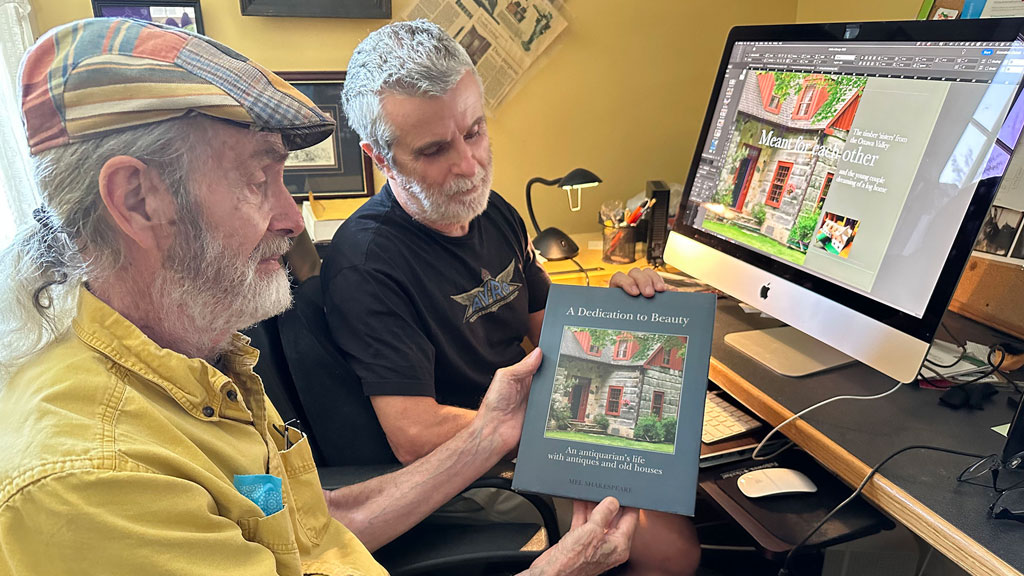Mel Shakespeare has been repurposing old buildings for decades, long before adaptive reuse was a thing in the building world.
Now the 82-year-old Cobourg, Ont. resident is in the final stages of writing a book that looks back on the mostly 19th century abandoned buildings he has brought back to life over his 57 years in the field.
Complete with 300 photos of 26 of his repurposed homes and buildings, the large format book “gives testament to an adaptive reuse that is more important now than it has ever been,” says Shakespeare who has saved well over 100 buildings from the wrecker’s ball during his career.
His book features period log homes and post-and-beam structures crafted from Ontario’s virgin forests and even a few stone houses rebuilt one stone at a time. Some of them were among the finest early homes in Ontario, he says.
“This book is something friends and others have been telling me to do for years but I just didn’t have the time,” he says, adding a first look at the yet-to-be published book has received favourable reviews from noted Ontario historians.
Shakespeare, owner of Tradition Home, doesn’t build houses anymore but still supplies historic logs, lumber/interior wood features and acts as a design consultant.
He got his start in 1967 after buying “a pile of century-old two-foot-wide squared logs lying under a snowbank.”
He paid $2,000, a price that would have sent many people running.
But Shakespeare, an art director for an advertising firm at the time, saw something in those logs others didn’t.
With little experience in construction but plenty of courage, he set about building the 30-by-22-foot storey-and-a-half home with his wife Jean and the help of a man with a crane to move and assemble the large hand-hewn logs.
“They fit together like a glove because the dovetail notched corners were so well made.”
A carpenter helped him build the roof. Chinking the spaces between the logs with mortar was tricky, a job botched by a masonry contractor before Shakespeare and his wife took over, learning some tips and tricks to mixing and applying historic mortar recipes from how-to books.
A year after building the house the couple furnished it with their collection of antiques “that looked like they were meant to be there all along.”
“I knew then that I could dedicate my life to bring this beauty to other old buildings.”
One of his most memorable projects was the conversion of what was sold to him by a farmer as a chicken coop.
“I was shocked when I opened the front door.”
Among the squawking chickens laying eggs, the dust and the poop, was an early 19th century post-and-beam structure intact with original panelled wainscoting, wide pine flooring and a fireplace surround…all in original paint colours.
“The farmer said if I was willing to pay him $2,000 he’d move the chickens back to the barn. It was a score for me — all it needed was a good cleaning.”
Shakespeare has had log house commissions from as far away as New Zealand. On one unusual job he transported logs from Ontario to assemble a replica of a pioneer home which was housed in a state museum in Austin, Texas.
Shakespeare’s book chronicles other novel projects he discovered in rural Ontario over years of extensive searching, often on old country roads.
“They weren’t easy to find and some weren’t in very good shape but you could buy them for as little as $500.”
For about a decade, he built squared log houses with new logs but in a number of cases the wood twisted and shrunk, resulting in gaps and ill-fitting windows and doors.
“We gave up on new timber after a while because of all the call-backs,” he says.
While most of his contracts have been rebuilds authentic to their original period of construction, Shakespeare would like to design a house that is “more of a mix of old logs and stone forming a more contemporary appearance.
“I have all the materials on my lot for it. If I get a client, it would be a really special home. It might also be the last house I design.”



Mel Shakespeare’s remarkable life experiences and natural gift for storytelling combined with what I’m sure will be stunning photographs make this a must have book. I’m looking forward to its publication!